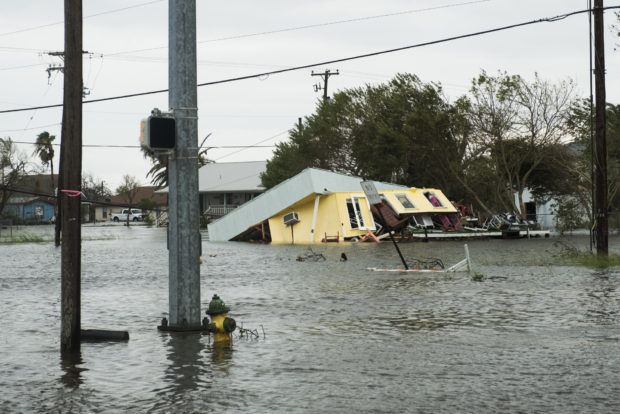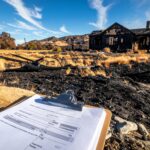In the aftermath of Hurricane Harvey and the flooding that followed, property/casualty insurers are ramping up for their widest use of drones to date to help facilitate the processing of catastrophe claims. Insurers are proceeding cautiously with commercial drone use, however, also relying on other technology to give them what they need.
“It is the widest use of [drones] yet, but it is still on a limited basis,” Loretta Worters, vice president of media relations for the Insurance Information Institute, told Carrier Management via email.
Insurers’ use of drones or other technology is coming into play as the Harvey storm disaster becomes one for the history books. Catastrophe modeling firm RMS noted that Harvey-related rainfall has already broken all U.S. records, reaching 51 inches in some spots. RMS also issued an updated estimate of economic losses due to Harvey-related wind, storm surge and inland flood, noting the final number could hit between $70 billion and $90 billion. Most of that is coming from flood damage, RMS said, noting that insured loss estimates are still yet to be tallied as rains and flooding continue.
Drone Use, Even if Limited, Remains Significant
Worters said that even if not all insurers are using drones and some are deploying them only on a limited basis, their use for Harvey damage will “still change the way claims are handled in many types of disasters going forward.”
Without naming specific insurers, Worters said she’s hearing many are using drones for Harvey in a test mode. Others, she said, aren’t relying on drones at all just yet.
“Some companies told me that they are going to use adjusters rather than drones,” Worters said. “The losses are not just the structure but inside with flooding, so they want to make sure that the claims are processed correctly.”
Instead, Worters noted that this is the first catastrophe that is using more sophisticated technology overall, including mobile catastrophe units with mapping software that helps locate homes and get to them before evacuated owners get home.
Drones are a part of this, she noted, allowing insurers to map three houses per hour, “while a claims adjuster can only visit three homes a day.”
Also, CAT vehicles with satellite capabilities are on the fringes of the Harvey disaster, able to provide claims handling. Mobile apps are also being beefed up to allow customers to submit claims even while being rescued, assuming they have cell service.
“It depends on the situation,” Worters said.
Insurers Ready With Drones and Other Tech
Allstate, USAA and Farmers are among insurers who said they are relying on drones and other technology to address claims demand in metro-Houston and other places where Harvey wreaked havoc.
Allstate plans to use drones to help assess Harvey damage, and crews are “awaiting deployment when conditions permit,” spokesperson Justin Herndon told Carrier Management.
Plans call for having vendor EagleView Technologies dispatch the drones with pilots, apart from Allstate claims personnel. Herndon said that they have access to as many drones as they need for as long as they  need them, though they were waiting for FAA clearance regarding the wider use of drones in the airspace as of earlier this week. (As of Aug. 30, the FAA issued temporary flight restrictions in areas of Houston and Beaumont in Texas that outline the coordination process for authorized use of commercial drones.)
need them, though they were waiting for FAA clearance regarding the wider use of drones in the airspace as of earlier this week. (As of Aug. 30, the FAA issued temporary flight restrictions in areas of Houston and Beaumont in Texas that outline the coordination process for authorized use of commercial drones.)
Beyond drones, Allstate is also planning to use its QuickCard Pay claims technology. Herndon said it allows the insurer to instantly put money back on a debit card, enabling instant payment for claims.
Allstate also used drones on a smaller scale after Hurricane Matthew and on a test basis in San Antonio last year after a hail event, he said.
Similarly, USAA said its drone provider, Datawing Global, will assist its claims adjusters in inspecting damage, according to Kristina Tomasetti, USAA’s innovation director. She said the insurer does have internal pilots available to fly if necessary, but “those resources are currently devoted to helping our members process their claims as quickly as possible to get them on their feet again.”
Tomasetti said that once conditions permit and the insurer has access to impacted areas, it will rely on drones to both get the images it needs for its members and to “keep our adjusters safe.”
Previously, Tomasetti said, USAA has tested and used drones in catastrophe situations elsewhere in Texas and Colorado, mostly to assess roof damage after hail events. The technology has been useful, she added.
“Drones have proven to have the potential to access areas such as high roofs to quickly inspect damage without sending an adjuster up on a ladder,” she said. “We are able to inspect a home in a fraction of the time, giving our adjusters more time to work with our members during their time of need.”
Farmers Insurance is waiting for weather conditions to stabilize in order to see how best to use its claims resources, including its drones, according to Tim Murray, head of Inside & National Property Claims for  Farmers.
Farmers.
“Our fleet of drones and the claims professionals who will be operating them are currently on standby and ready to deploy when conditions make it safe to do so,” Murray said. “Our focus will be to leverage this technology to assist with our claim assessments, and we believe our new drone program will help improve response time and safety for our claim representatives during their evaluations.”
Murray added that drones offer some significant technical advantages.
“From a technical standpoint, the drones’ industrial design camera captures higher-resolution, 3-D images capable of detecting granule loss and physical damage, which provides an accurate rooftop inspection and can generate analytic reports in minutes,” Murray said.
Farmers said it had approximately 500,000 policyholders in Harvey’s path—400,000 homeowners and approximately 100,000 auto and business policies.
See Related Claims Journal Story: Update: Claims Teams Begin Handling Onslaught of Harvey Claims





















 Unpacking a Consumer Intervenor’s Novel Idea
Unpacking a Consumer Intervenor’s Novel Idea  Executives on the Move at HSB, American Modern Insurance Group, AIG
Executives on the Move at HSB, American Modern Insurance Group, AIG  What to Expect in 2026: U.S. P/C Results More Like 2024
What to Expect in 2026: U.S. P/C Results More Like 2024  How Carriers Are Pairing AI and Process Discipline to Drive Subrogation Outcomes
How Carriers Are Pairing AI and Process Discipline to Drive Subrogation Outcomes 








